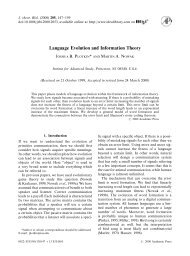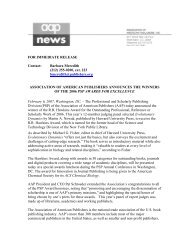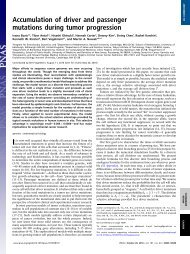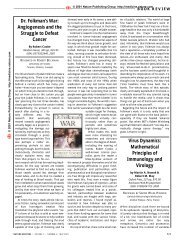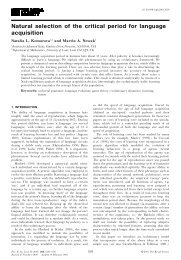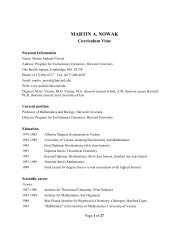Excerpt - Program for Evolutionary Dynamics - Harvard University
Excerpt - Program for Evolutionary Dynamics - Harvard University
Excerpt - Program for Evolutionary Dynamics - Harvard University
Create successful ePaper yourself
Turn your PDF publications into a flip-book with our unique Google optimized e-Paper software.
EVOLUTIONARY<br />
DYNAMICS<br />
EXPLORING THE EQUATIONS OF LIFE<br />
MARTIN A. NOWAK<br />
THE BELKNAP PRESS OF HARVARD UNIVERSITY PRESS<br />
CAMBRIDGE, MASSACHUSETTS, AND LONDON, ENGLAND 2006
Copyright © 2006 by the President and Fellows of <strong>Harvard</strong> College<br />
All rights reserved<br />
Printed in Canada<br />
Library of Congress Cataloging-in-Publication Data<br />
Nowak, M. A. (Martin A.)<br />
<strong>Evolutionary</strong> dynamics : exploring the equations of life /<br />
Martin A. Nowak.<br />
p. cm.<br />
Includes bibliographical references and index.<br />
ISBN-13: 978-0-674-02338-3 (alk. paper)<br />
ISBN-10: 0-674-02338-2 (alk. paper)<br />
1. Evolution (Biology)—Mathematical models. I. Title.<br />
QH371.3.M37N69 2006<br />
576.801 ′ 5118—dc22 2006042693<br />
Designed by Gwen Nefsky Frankfeldt
CONTENTS<br />
Preface ix<br />
1 Introduction 1<br />
2 What Evolution Is 9<br />
3 Fitness Landscapes and Sequence Spaces 27<br />
4 <strong>Evolutionary</strong> Games 45<br />
5 Prisoners of the Dilemma 71<br />
6 Finite Populations 93<br />
7 Games in Finite Populations 107<br />
8 <strong>Evolutionary</strong> Graph Theory 123<br />
9 Spatial Games 145<br />
10 HIV Infection 167<br />
11 Evolution of Virulence 189<br />
12 <strong>Evolutionary</strong> <strong>Dynamics</strong> of Cancer 209<br />
13 Language Evolution 249<br />
14 Conclusion 287<br />
Further Reading 295<br />
References 311<br />
Index 349
PREFACE<br />
<strong>Evolutionary</strong> <strong>Dynamics</strong> presents those mathematical principles according to<br />
which life has evolved and continues to evolve. Since the 1950s biology, and<br />
with it the study of evolution, has grown enormously, driven by the quest to<br />
understand the world we live in and the stuff we are made of. Evolution is the<br />
one theory that transcends all of biology. Any observation of a living system<br />
must ultimately be interpreted in the context of its evolution. Because of the<br />
tremendous advances over the last half century, evolution has become a discipline<br />
that is based on precise mathematical foundations. All ideas regarding<br />
evolutionary processes or mechanisms can, and should, be studied in the context<br />
of the mathematical equations of evolutionary dynamics.<br />
The original <strong>for</strong>mulation of evolutionary theory and many of the investigations<br />
of its first hundred years dealt with the genetic evolution of the origin<br />
and adaptation of species. But more recently evolutionary thinking has expanded<br />
to all areas of biology and many related disciplines of the life sciences.<br />
Wherever in<strong>for</strong>mation reproduces, there is evolution. Mutations are caused by<br />
errors in in<strong>for</strong>mation transfer, resulting in different types of messages. Selection<br />
among types emerges when some messages reproduce faster than others.<br />
ix
Mutation and selection make evolution. Mutation and selection can be described<br />
by exact mathematical equations. There<strong>for</strong>e evolution has become a<br />
mathematical theory.<br />
The life sciences in general, and biology in particular, are on the brink of<br />
an unprecedented theoretical expansion. Every university is currently aiming<br />
to establish programs in mathematical biology and to offer its students an<br />
interdisciplinary education that spans fields as diverse as mathematics and<br />
molecular biology, linguistics and computer science. At the borders of such<br />
disciplines, progress occurs. Whenever the languages of two disciplines meet,<br />
two cultures interact, and something new happens.<br />
In this book, the languages of biology and mathematics meet to talk about<br />
evolution. <strong>Evolutionary</strong> <strong>Dynamics</strong> introduces the reader to the fascinating and<br />
simple laws that govern the evolution of living systems, however complicated<br />
they may seem. I will start with the basics, avoid unnecessary complications,<br />
and reach cutting-edge research problems within a few steps.<br />
The book grew out of a course I taught at <strong>Harvard</strong> <strong>University</strong> in 2004<br />
and 2005. The students in my first class were Blythe Adler, Natalie Arkus,<br />
Michael Baym, Paul Berman, Illya Bomash, Nathan Burke, Chris Clearfield,<br />
Rebecca Dell, Samuel Ganzfried, Michael Gensheimer, Julia Hanover, David<br />
Hewitt, Mark Kaganovich, Gregory Lang, Jonathan Leong, Danielle Li, Alex<br />
Macalalad, Shien Ong, Ankit Patel, Yannis Paulus, Jura Pintar, Esteban Real,<br />
Daniel Rosenbloom, Sabrina Spencer, and Martin Willensdorfer, and the<br />
teaching fellows Erez Lieberman, Franziska Michor, and Christine Taylor. I<br />
have learned much from you. Your questions were my motivation. I wrote this<br />
book <strong>for</strong> you.<br />
I am indebted to many people. Most of all I would like to thank May Huang<br />
and Laura Abbott, who helped me to prepare the final manuscript and index.<br />
They turned chaos into order. I could not have finished without them. I also<br />
thank the excellent editors of <strong>Harvard</strong> <strong>University</strong> Press, Elizabeth Gilbert and<br />
Michael Fisher.<br />
I thank Ursula, Sebastian, and Philipp <strong>for</strong> their patience and <strong>for</strong> their burning<br />
desire to understand everything that can be understood.<br />
I would like to express my gratitude to my teachers, Karl Sigmund and<br />
Robert May. Both of them are shining examples of how scientists should be.<br />
They have again and again impressed me with their superior judgment, in-<br />
x PREFACE
sight, and generosity. I also appreciate the work and friendship of the many<br />
people with whom I have had the honor of collaborating and whose enthusiasm<br />
<strong>for</strong> science is woven into the ideas presented here: Roy Anderson, Rustom<br />
Antia, Ramy Arnaout, Charles Bangham, Barbara Bittner, Baruch Blumberg,<br />
Maarten Boerlijst, Sebastian Bonhoeffer, Persephone Borrow, Reinhard<br />
Bürger, Michael Doebeli, Peter Doherty, Andreas Dress, Ernst Fehr, Steve<br />
Frank, Drew Fudenberg, Beatrice Hahn, Christoph Hauert, Tim Hughes,<br />
Lorens Imhof, Yoh Iwasa, Vincent Jansen, Paul Klenerman, Aron Klug, Natalia<br />
Komarova, David Krakauer, Christoph Lengauer, Richard Lenski, Bruce Levin,<br />
Erez Lieberman, Jeffrey Lifson, Marc Lipsitch, Alun Lloyd, Joanna Masel, Erick<br />
Matsen, Lord May of Ox<strong>for</strong>d (Defender of Science), John Maynard Smith,<br />
Angela McLean, Andrew McMichael, Franziska Michor, Garrett Mitchener,<br />
Richard Moxon, Partha Niyogi, Hisashi Ohtsuki, Jorge Pacheco, Karen Page,<br />
Robert Payne, Rodney Phillips, Joshua Plotkin, Roland Regoes, Ruy Ribeiro,<br />
Akira Sasaki, Charles Sawyers, Peter Schuster, Anirvan Sengupta, Neil Shah,<br />
George Shaw, Karl Sigmund, Richard Southwood, Ed Stabler, Dov Stekel,<br />
Christine Taylor, David Tilman, Peter Trappa, Arne Traulsen, Bert Vogelstein,<br />
Lindi Wahl, Martin Willensdorfer, and Dominik Wodarz.<br />
I thank Jeffrey Epstein <strong>for</strong> many ideas and <strong>for</strong> letting me participate in his<br />
passionate pursuit of knowledge in all its <strong>for</strong>ms.<br />
PREFACE xi
INTRODUCTION<br />
IN 1831, at the age of twenty-two, Charles Darwin embarked on his journey<br />
around the world. He gazed at the breath-taking diversity of tropical flora and<br />
fauna, collected creepy-crawlies from the vast oceans that he traversed, was<br />
hopelessly seasick, saw slavery in Brazil, witnessed genocide in Argentina, and<br />
was underwhelmed by the naked humanity at Tierra del Fuego. He experienced<br />
the effects of a devastating earthquake in Chile that raised the South<br />
American continent. He led an expedition into the Andes and discovered marine<br />
fossils at high altitude. He paid little attention to which finches came from<br />
which islands in the Galápagos and ate most of the delicious turtles he had<br />
gathered on his way home across the Pacific. He saw Tahiti and the economic<br />
rise of Australia. He visited John Hershel, England’s leading physicist of the<br />
time, in South Africa; Hershel told him that “the mystery of mysteries” was the<br />
as yet unknown mechanism that gave rise to new species. Darwin returned to<br />
England’s shores after five years, having collected six thousand specimens that<br />
would require decades of analysis by an army of experts.<br />
His own observations in geology and the theory of his mentor, Sir Charles<br />
Lyell, that mountains were not lifted up in one day, but rose slowly over<br />
1<br />
1
unimaginable periods of time, led Darwin to a key idea: given enough time<br />
everything can happen.<br />
Charles Darwin did not invent the concept of evolution. When he was a<br />
student in Edinburgh in the late 1820s, evolution was already the talk of the<br />
town. But evolution was rejected by the establishment. Those who adhered<br />
to evolutionary thinking were called Lamarckists, after the French scientist<br />
Jean-Baptiste Lamarck, who was the first to propose that species are not static,<br />
but change over time and give rise to new species. Lamarck had offered this<br />
perspective in a book published in 1809. He did not, however, propose a<br />
correct mechanism <strong>for</strong> how species change into each other. This mechanism<br />
was discovered first by Charles Darwin and independently by Alfred Russel<br />
Wallace.<br />
From reading the economist Thomas Malthus, Darwin was aware of the<br />
consequences of exponentially growing populations. Once resources become<br />
limiting only a fraction of individuals can survive. Darwin was also a keen<br />
observer of animal breeders. He analyzed their methods and studied their<br />
results. Slowly he understood that nature acted like a gigantic breeder. This was<br />
the first time that natural selection materialized as an idea, a scientific concept<br />
in a human mind. Darwin was thirty-three years old.<br />
The one problem that Darwin did not solve concerned the mechanism<br />
that could maintain enough diversity in a population <strong>for</strong> natural selection<br />
to operate. Darwin was unaware of the Austrian monk and botanist Gregor<br />
Mendel and his experiments on plant heredity. Mendel’s work had already<br />
been published but was hidden, gathering dust in the Annals of the Brno<br />
Academy of Sciences.<br />
Darwin once remarked, “I have deeply regretted that I did not proceed far<br />
enough at least to understand something of the great leading principles of<br />
mathematics; <strong>for</strong> men thus endowed seem to have an extra sense.” The engineer<br />
Fleeming Jenkins, who reviewed Darwin’s On the Origin of Species, published<br />
in 1859, had raised a fundamental and seemingly intractable objection<br />
to Darwin’s theory: if offspring inherit a blend of the parents’ characteristics,<br />
then variability diminishes in successive generations. Several decades later a<br />
simple mathematical equation, independently found by the famous British<br />
mathematician G. H. Hardy and the German physician Wilhelm Weinberg,<br />
showed that Mendelian (particulate) inheritance does lead to a maintainance<br />
2 EVOLUTIONARY DYNAMICS
of genetic diversity under random mating. The Hardy-Weinberg law is one of<br />
the fundamental principles of evolution under sexual reproduction.<br />
Mendelian genetics and Darwinian evolution were unified in the new discipline<br />
of mathematical biology, which developed from the seminal investigations<br />
of Ronald Fisher, J. B. S. Haldane, and Sewall Wright in the 1920s and<br />
1930s. Through their work, fundamental concepts of evolution, selection, and<br />
mutation were embedded in a precise mathematical framework. This line of<br />
mathematical analysis was taken up in the 1950s by Motoo Kimura, who <strong>for</strong>mulated<br />
the neutral theory of evolution. Kimura realized that most genetic<br />
mutations do not affect fitness and are fixed in populations only by random<br />
drift.<br />
Other milestones of evolutionary dynamics include William Hamilton’s discovery<br />
in 1964 that selection of “selfish genes” can favor altruistic behavior<br />
among relatives and John Maynard Smith’s invention of evolutionary game<br />
theory in 1973. In the mid-1970s Robert May revolutionized the mathematical<br />
approaches to ecology and epidemiology. Manfred Eigen and Peter Schuster<br />
<strong>for</strong>mulated quasispecies theory, which provides a link between genetic evolution,<br />
physical chemistry, and in<strong>for</strong>mation theory. Peter Taylor, Josef Hofbauer,<br />
and Karl Sigmund studied the replicator equation, the foundation of evolutionary<br />
game dynamics.<br />
This very brief and incomplete account of the evolution of evolutionary<br />
dynamics brings us to the present book. It has fourteen chapters. Although<br />
there is some progression of complexity, the chapters are largely independent.<br />
There<strong>for</strong>e, if you know something about the subject, you can read the book in<br />
whatever order you like. My aim has been to keep things as simple as possible,<br />
as linear as possible, and as deterministic as possible. I will start with the basics<br />
and in a few steps lead you to some of the most interesting and unanswered<br />
research questions in the field. Having read the book, you will know what you<br />
need to embark on your own journey and make your own discoveries.<br />
This book represents an introduction to certain aspects of mathematical<br />
biology, but it is not comprehensive. Mathematical biology includes many topics,<br />
such as theoretical ecology, population genetics, epidemiology, theoretical<br />
immunology, protein folding, genetic regulatory networks, neural networks,<br />
genomic analysis, and pattern <strong>for</strong>mation. The field is too diverse <strong>for</strong> any one<br />
book to represent it without running the risk of becoming as entertaining as a<br />
INTRODUCTION 3
telephone directory. I have chosen those topics that I know well and where<br />
my explanation can be brief and effective. I have concentrated on evolution<br />
because it is the one unifying principle of all of biology.<br />
It might seem surprising that a book on evolutionary dynamics is not primarily<br />
about population genetics. Nevertheless the ideas and concepts of this<br />
fascinating field stand behind many of my explorations: the basic mathematical<br />
<strong>for</strong>mulations of selection, mutation, random drift, fitness landscapes, and<br />
frequency-dependent selection as well as of evolution in structured populations<br />
have originated in population genetics. Several major themes of population<br />
genetics, however, such as sexual reproduction, sexual selection, recombination,<br />
and speciation, are not discussed here. In contrast, classical population<br />
genetics does not deal with evolutionary dynamics of infectious agents, the<br />
somatic evolution of cancer, evolutionary game theory, or the evolution of human<br />
language, all of which are subjects that I do explore.<br />
The main ingredients of evolutionary dynamics are reproduction, mutation,<br />
selection, random drift, and spatial movement. Always keep in mind that<br />
the population is the fundamental basis of any evolution. Individuals, genes,<br />
or ideas can change over time, but only populations evolve.<br />
The structure of the book is as follows. After this introduction, in Chapter<br />
2 I will discuss populations of reproducing individuals and the basic ideas of<br />
natural selection and mutation. Simple models of population dynamics can<br />
lead to an exponential explosion, to a stable equilibrium, or to oscillations<br />
and chaos. Selection emerges whenever two or more individuals reproduce<br />
at different rates. Mutation means that one type can change into another.<br />
There are models of population growth that lead to the survival of whoever<br />
reproduces fastest (“survival of the fittest”). Other models lead to the survival<br />
of the first or the coexistence of all.<br />
In Chapter 3, quasispecies theory is introduced. Quasispecies are populations<br />
of reproducing genomes subject to mutation and selection. They live<br />
in sequence space and move over fitness landscapes. An important relationship<br />
between mutation rates and genome length is called the “error threshold”:<br />
adaptation on most fitness landscapes is possible only if the mutation rate per<br />
base is less than one over the genome length, measured in bases.<br />
In Chapter 4, we study evolutionary game dynamics, which arise whenever<br />
the fitness of an individual is not constant but depends on the relative<br />
4 EVOLUTIONARY DYNAMICS
abundance (= frequency) of others in the population. Thus evolutionary game<br />
theory is the most comprehensive way to look at the world. People who do<br />
not engage in evolutionary game theory restrict themselves to the rigidity of<br />
constant selection, where the fitness of one individual does not depend on others.<br />
The replicator equation is a nonlinear differential equation that describes<br />
frequency-dependent selection among a fixed number of strategies. We will<br />
encounter the Nash equilibrium and evolutionarily stable strategies. <strong>Evolutionary</strong><br />
game theory and ecology are linked in an important way: the replicator<br />
equation is equivalent to the Lotka-Volterra equation of ecological systems,<br />
which describes the interation between predator and prey species.<br />
Chapter 5 is dedicated to the best game in town, the Prisoner’s Dilemma.<br />
The cooperation of reproducing entities is essential <strong>for</strong> evolutionary progress.<br />
Genes cooperate to <strong>for</strong>m a genome. Cells cooperate to produce multicellular<br />
organisms. Individuals cooperate to <strong>for</strong>m groups and societies. The emergence<br />
of human culture is a cooperative enterprise. The very problem of how to obtain<br />
cooperation by natural selection is described by the Prisoner’s Dilemma.<br />
In the absence of any other assumption, natural selection favors defectors over<br />
cooperators. Cooperation has a chance, however, if there are repeated interactions<br />
between the same two individuals. We will encounter the strategy Tit<strong>for</strong>-tat,<br />
which is defeated first by Generous Tit-<strong>for</strong>-tat and then by Win-stay,<br />
lose-shift.<br />
In Chapter 6 we move to a stochastic description of finite populations. Neutral<br />
drift is a crucial aspect of evolutionary dynamics: if a finite population<br />
consists of two types of individuals, red and blue, and if both individuals have<br />
identical fitness, then eventually the population will be either all red or all blue.<br />
Even in the absence of selection, coexistence is not possible. If there is a fitness<br />
difference, then the fitter type has a greater chance of winning, but no certainty.<br />
We calculate the probability that the descendants of one individual will<br />
take over the whole population. This so-called fixation probability is important<br />
<strong>for</strong> estimating the rate of evolution.<br />
Chapter 7 is about games in finite populations. Most of evolutionary game<br />
theory has been <strong>for</strong>mulated in terms of deterministic dynamics describing<br />
the limit of infinitely large populations. Here we move game theory to finite<br />
populations and make surprising observations. Neither a Nash equilibrium,<br />
nor an evolutionarily stable strategy, nor a risk-dominant strategy is protected<br />
INTRODUCTION 5
y natural selection. There can be advantageous mutants against all three. In<br />
a bistable situation between two strategies, there is a simple “1/3 rule” that<br />
determines whether a strategy is favored by natural selection.<br />
In Chapter 8, the individuals of a population are represented by the vertices<br />
of a graph. The edges of the graph specify who interacts with whom. The graph<br />
can denote spatial relationships or social networks. The first observations of<br />
“evolutionary graph theory” are reported. The classical homogeneous population<br />
is defined by the complete graph, where all vertices are connected. We<br />
will see that circulations have the same evolutionary behavior as the complete<br />
graph in terms of fixation probability under constant selection, and there<strong>for</strong>e<br />
represent a particular balance between drift and selection. Graphs that<br />
enhance drift act as suppressors of selection. Graphs that reduce drift act as<br />
amplifiers of selection. In the limit of large population size, there exist graphs<br />
that guarantee the fixation of any advantageous mutant and the extinction of<br />
any disadvantageous mutant. Games on graphs are also studied in this chapter.<br />
There is a remarkably simple rule <strong>for</strong> the evolution of cooperation.<br />
Chapter 9 gives an account of evolutionary game dynamics on spatial grids.<br />
The primary approach will be deterministic, discrete in time, and discrete in<br />
space. This approach brings together game theory and cellular automata. We<br />
will observe evolutionary kaleidoscopes, dynamic fractals, and spatial chaos.<br />
There is all the complexity one could ever wish <strong>for</strong>—making it unnecessary<br />
<strong>for</strong> God to play dice. Moreover, cooperation can evolve on spatial grids. This<br />
is the concept of “spatial reciprocity.”<br />
In Chapter 10, we study the evolutionary dynamics of virus infections. I<br />
will argue that the mechanism of disease progression caused by the human<br />
immunodeficiency virus (HIV) is an evolutionary one. The immune system<br />
constantly attacks the virus, but the virus continuously evolves away, appears<br />
elsewhere in sequence space, and eventually overpowers the immune system.<br />
The resulting “diversity threshold theory” can explain why people succumb to<br />
the fatal immunodeficiency disease AIDS after a long and variable infection<br />
with HIV.<br />
Chapter 11 discusses the evolution of infectious agents, their attempts to<br />
infect new hosts, and the selection pressures that determine the level of virulence.<br />
The conventional wisdom is that well-adapted parasites are harmless<br />
to their hosts. This perspective is revised in the context of evolutionary dy-<br />
6 EVOLUTIONARY DYNAMICS
namics. Competition between different mutants of a parasite maximizes its<br />
basic reproductive ratio. Superinfection takes into account that parasites compete<br />
on two levels of selection: within an infected host and in the population<br />
of hosts. Superinfection holds many surprising aspects, including the shortsighted<br />
evolution of higher and higher virulence beyond what would be optimum<br />
<strong>for</strong> the parasite.<br />
Chapter 12 explores the evolutionary dynamics of human cancer. Cancer<br />
arises when cooperation among cells breaks down. The mutated cells revert to<br />
their primitive program of uncontrolled replication. We calculate the rate of<br />
activation of oncogenes and inactivation of tumor suppressor genes. We analyze<br />
the impact of mutations that trigger “genetic instability.” We outline the<br />
conditions necessary <strong>for</strong> “chromosomal instability” to initiate cancer progression.<br />
Chapter 13 is devoted to the evolutionary dynamics of the one trait that<br />
is truly our own invention and that is arguably the one interesting thing that<br />
has happened in the last six hundred million years on earth. Bacteria invented<br />
all the biochemistry of life. Eukaryotes invented some advanced genetics and<br />
how to build complicated multicellular plants and animals. Humans will be<br />
remembered <strong>for</strong> language.<br />
Chapter 14 summarizes and concludes. Further readings will be found at<br />
the back of the book.<br />
All the diverse topics of this book are unified by evolutionary dynamics. The<br />
mathematical description of evolution has moved from the study of purely<br />
genetic systems to any kind of process where in<strong>for</strong>mation is being reproduced<br />
in a noisy (= natural) environment. What you will encounter in this book is<br />
responsible <strong>for</strong> shaping life around you. Every living system, and everything<br />
that arises as a consequence of living systems, is a product of evolutionary<br />
dynamics.<br />
INTRODUCTION 7




